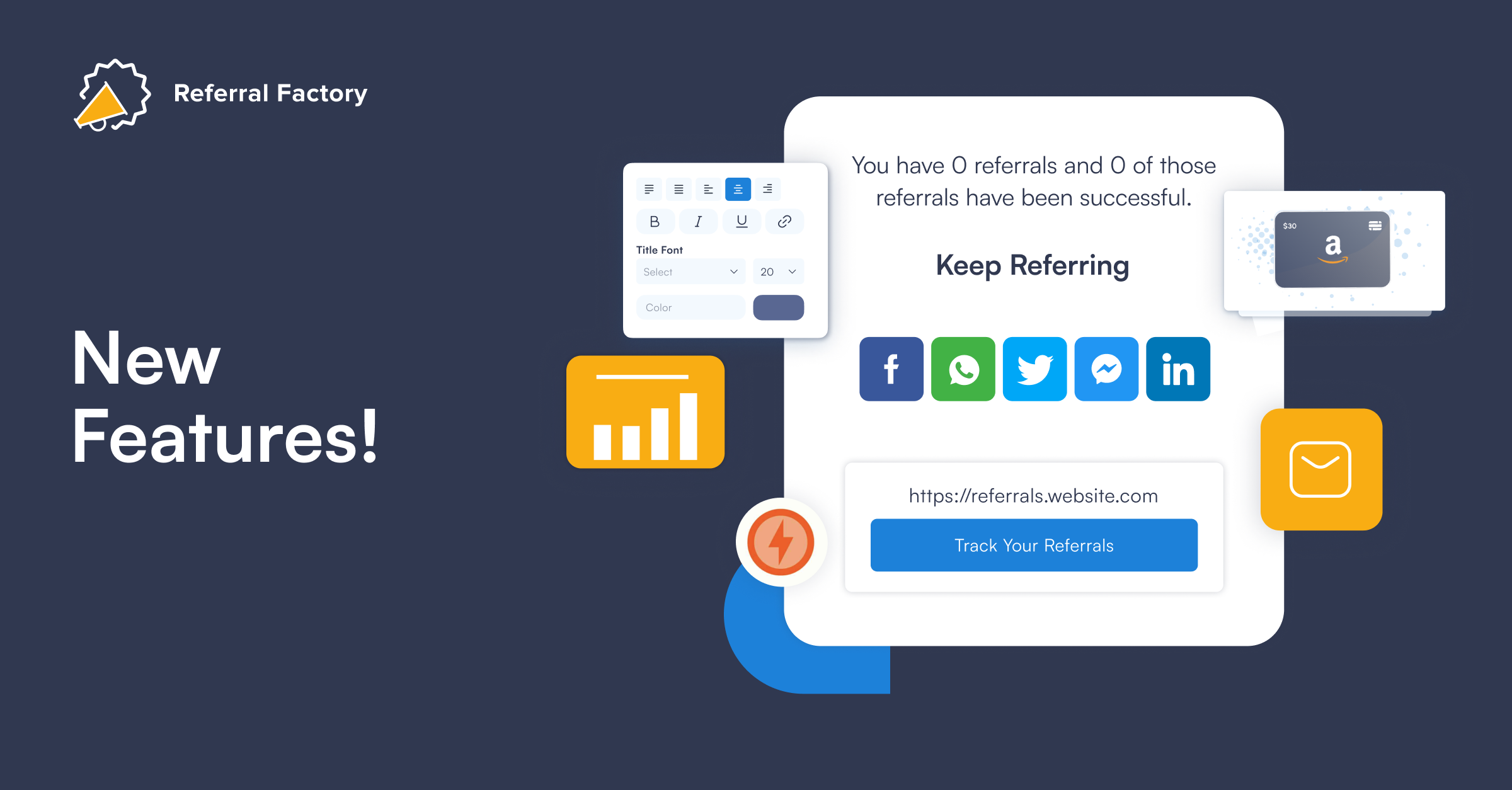Top Referral Program Incentives (Backed by Data from Real Referral Programs)
Offering a referral program to your customers is an exciting step. Yet, many businesses that start doing referral marketing often stumble upon the choice of incentives. The question that quickly throws a wrench in the works is: how exactly should I incentivize people? Should I reward every participant? The rabbit hole just goes deeper! Should I pay more for the first referral or the following ones? Should I offer a discount or cash?
It sounds overwhelming but, rest assured, we’re here to break it down for you. In fact, the solution is much more straightforward than it seems. Let’s ditch the overwhelm and craft the perfect referral program incentive. Keep reading!
Table of Contents
Referral Program Incentives: What Are They, and Why Do You Need Them?
Let’s make it simple: referral program incentives are rewards offered to customers who successfully refer your business to someone else. That’s it! Think of the strategy as a way to say “thank you” for spreading the love and helping your business grow. This is a sign that the existing customers value your business so much that they want others to try it, too. So, why don’t you reward them for their loyalty?
While a referral program incentive isn’t the only factor that drives referrals, it can certainly motivate both your existing customers and their friends. By offering an attractive incentive, you give people an extra reason to share their positive experiences with your business. And here’s a bonus: by throwing in incentives, you’re helping them encourage others to give you a try. So, you get more customers, who, in turn, can bring you even more customers! This is what happens when you turn your customer base into your best marketing team.
Still, choosing the right referral marketing incentives isn’t just about throwing out any reward blindly. It’s essential to consider several factors to ensure your referral marketing strategy is successful. These include:
✅ Understanding what motivates your customers. What types of incentives are most appealing to your target audience? Do they value discounts, upgrades, free products, exclusive experiences, or something else? What aligns the most with your type of business?
✅ Setting a budget. How much can you spend on incentives without losing out on your profit margins? What is your customer acquisition cost? In the end, your budget will significantly affect the type of referral program you’ll set up.
✅ Calculating the value of each referral. Preparation is everything. You can use the average customer lifetime value (i.e., customer value times by average customer lifespan) and determine a reasonable incentive amount. And, of course, your referral program must align with your business goals.
✅ Coming up with a tracking system. It might be hard to track who refers whom. Usually, if you have under 50 customers, you can monitor the progress manually. But, if your business is larger, make sure you have the resources to manage this process effectively. That’s where referral software will come in handy, allowing you to track participants and conversions and even run multiple referral campaigns (if needed).
✅ Checking legal and tax regulations. Depending on your industry and location, you might need to consider specific laws. In addition, remember to consult the tax requirements for your rewards.
Top-Performing Referral Program Incentives Based on Data From Real Referral Programs
It is no secret that some incentives work better than others. It depends a lot on your business, of course, but generally, people consider some rewards more motivational than others across all industries. Let’s take a look at what the data has to say about the best referral program incentives:
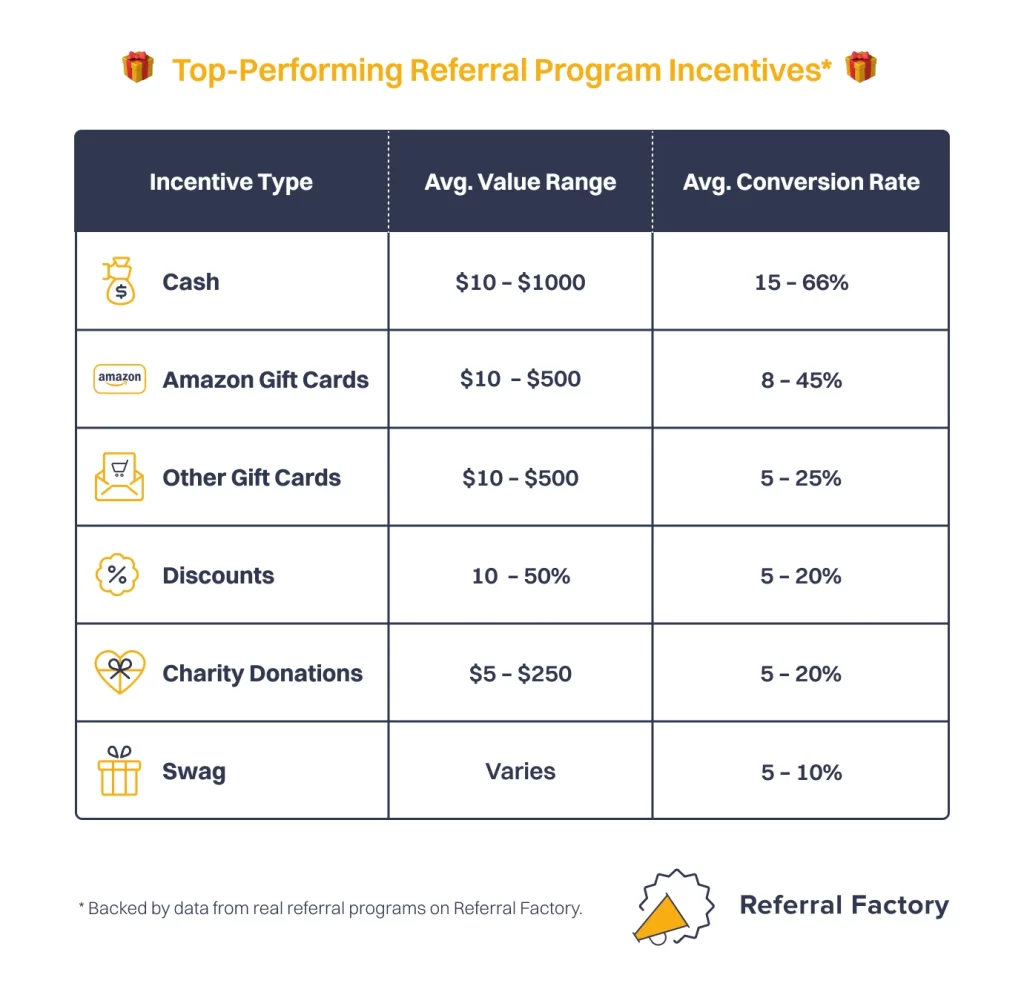
Amazon vouchers and cash are on top of the list for an apparent reason: simplicity. They are really easy to claim and spend, which is often a good motivation for both the person referring (your customer spreading the word about your product) and the person invited (the friend of a person referring or your new lead). Integrating these options is often a great way to improve your referral program conversions. So, if these incentives suit your business, don’t hesitate to try them out.
Still, apart from statistics, you have to consider the specifics of your industry. What are those? Read on to find out…
Choosing the Best Incentives for Your Referral Program
Developing a successful referral program involves careful selection of the right incentives to encourage customer participation. Let’s take a look at your options:
- Reward in your own currency. If your customers make recurring payments for your products or services, this might be a good option for you (e.g., for a subscription-based business). In this case, offering discounts or extended service periods within your own ecosystem can be a powerful motivator. For example, you can give out free products. First, everybody likes to get something cool for free. Plus, by giving customers branded products without them having to pay for them, you create a positive experience and a motivation to spread the word about your brand even further. Another option is discounts. Special offers attract new customers and make the existing ones value the brand more. This is a very easy way of getting an immediate engagement and driving retention!
- Consider global rewards. While rewarding in your own currency can be effective, it does not work for everyone. If your business doesn’t work with people buying from you regularly, discounts or freebies might not be the most motivating reward. What should you try instead? As we’ve seen in the previous section, cash rewards and Amazon vouchers are some of the best rewards you can offer. And the best part is that these incentives work for almost any industry. Besides, they resonate with a broader audience, especially compared to the brand-specific rewards.
- Collaborate with other businesses. Collaborating with companies related to your niche is a great way to not only promote your referral campaign but also offer exclusive co-branded incentives. It’s a win-win situation for both parties.
- Offer gift cards. Gift cards are a practical solution. Compared to personalized incentives, gift cards can often be a budget-friendly solution while maximizing ROI. They can also help you target a bigger audience and increase the chances of reward satisfaction among both the person referring and the person invited.
The variety of reward options might be overwhelming. We get that. But the best thing you can do if you’re just starting is to take it easy. What do we mean by that? Begin by creating a single referral campaign that targets one type of audience (e.g., only your customers, only your partners, or only your employees). Then, choose one type of reward and set very clear rules for participation in your referral campaign. You don’t need a lot of text or overly complicated descriptions. Forget about that. You need a few sentences, that’s it.
How to Structure Referral Program Incentives?
When designing a customer referral program, remember that simplicity is what you need. People have short attention spans, so forget about elaborate structures: your referral program rules have to be understandable at a single glance.
Let’s take a look at the tried-and-true approaches to help you choose the most effective referral incentives:
Single-Sided vs. Double-Sided
First, you have to decide who gets rewarded. It can be the person referring, the person invited, or both.
- Single-sided. These referral programs mean you only incentivize one group of participants, either the person referring or the person invited.
- Double-sided. This approach incentivizes both parties. Still, the incentives for a person invited and for a person referring are usually different. This is the most common practice across industries, and for good reason! It’s a win-win.
Which one should you choose? The decision will depend on your budget, industry, and any legal issues. Remember, however, that double-sided campaigns tend to be more effective as it’s a win-win approach.
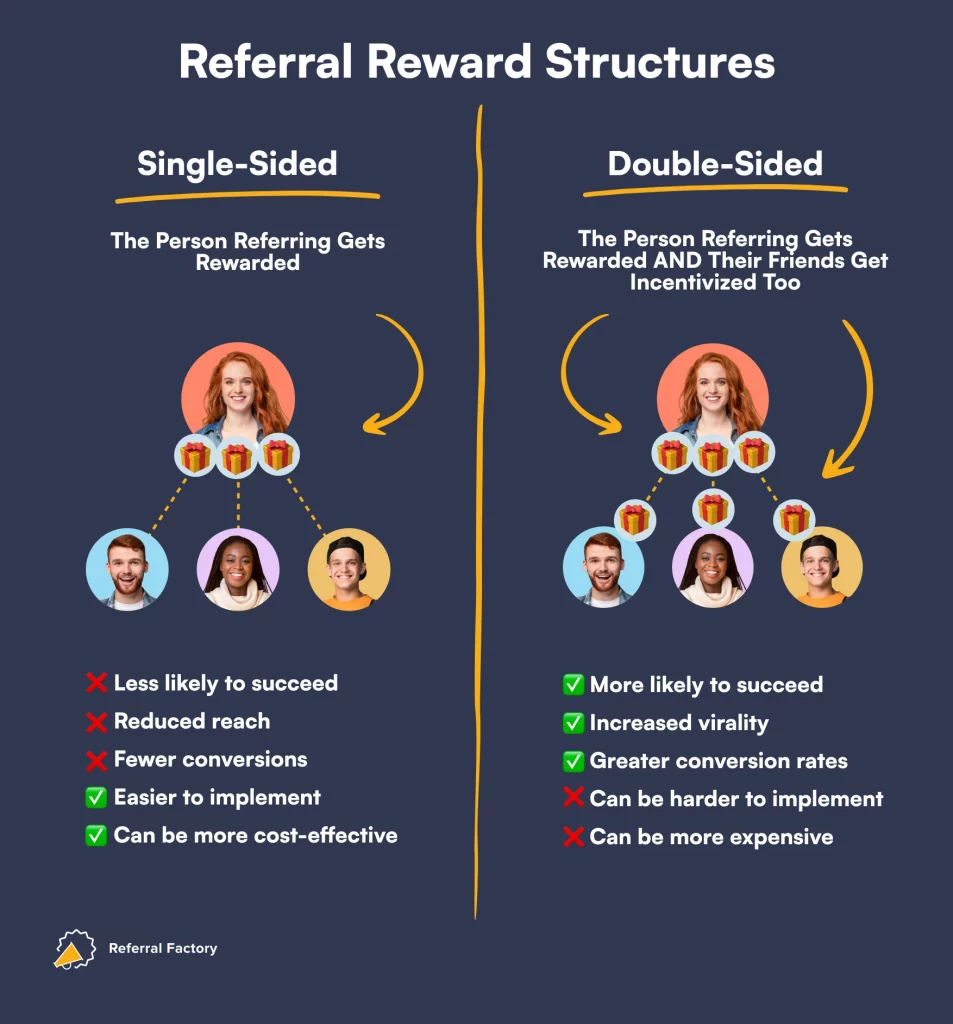
Fixed Value vs. Milestone vs. Commission-Based vs. Recurring
Once you know who you want to incentivize, you must decide how to structure your incentives. Will you have a fixed or commission-based reward? Will your rewards increase as a person brings in more friends or reaches a certain target number of referrals? It might sound complicated, but it gets easier when you know your options.
- Fixed Value. This is the simplest approach to a referral program incentive and is the best solution for a good old-fashioned customer referral program! The basic idea is that you give a set amount for every new successful referral.
- Milestone (sometimes called tiered/stacked). This type of incentive structure is based on the following idea: the more referrals, the better the reward. For example, if you bring in one person who converts, you get $5; then, once you bring in 3 friends, you get $20; and $40 for 5 people invited.
- Commission-based. These rewards are proportional to the value generated by your referrer. Usually, participants get a percentage of sales. For example, the more your friend spends, the higher your reward is. These work super well for affiliate programs.
- Recurring rewards. These are either fixed value or commission-based incentives that pay out at regular intervals, like once a month! These kinds of incentives are super popular for SaaS referral programs, which work on a subscription-based revenue model.
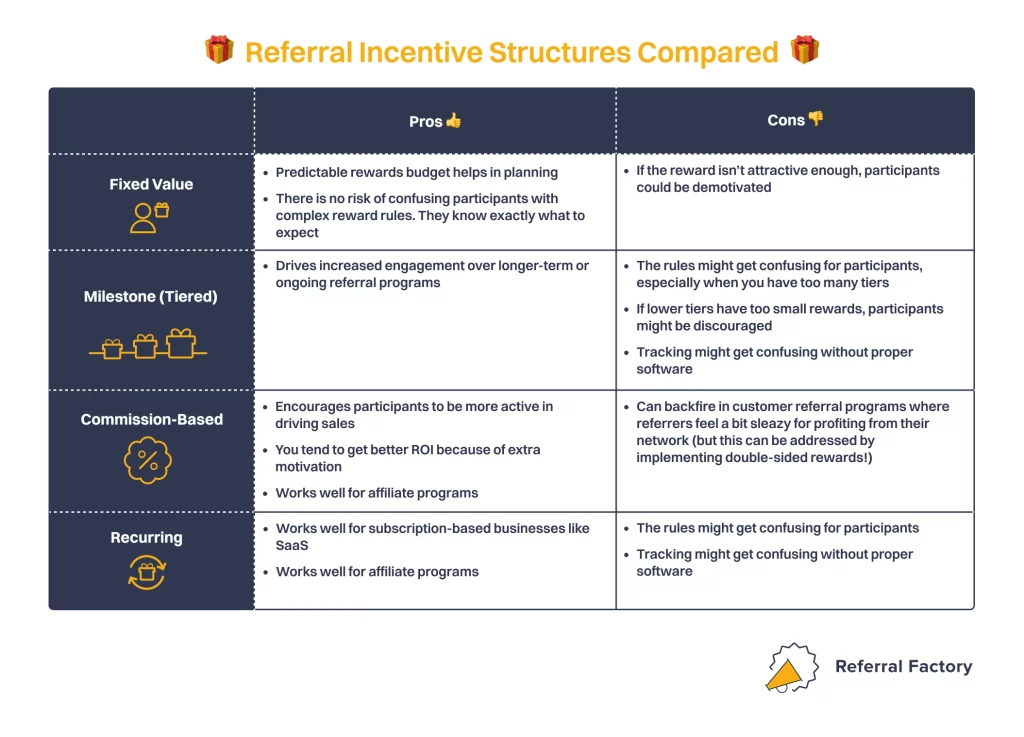
B2B Referral Program Incentives
Unlike their consumer-targeted cousins, B2B involves collective decisions, extended timelines, and a dose of “show me the numbers.”A B2B referral program is a bit more challenging to plan because of one key consideration: who should you reward for recommending a product or service? The business entity? Or the individual doing the referring?
While offering rewards directly to businesses can be effective, our experience (backed by the data) suggests a little addition to that: directing incentives towards the individuals doing the referring (normally employees of the business) can be much more impactful in driving your referral program’s success. So, if you reward the person referring AND the business they work for, it could be much more beneficial.
Consider, for example, a scenario where the marketing manager within a large corporation recommends your B2B service to their network. If that new lead converts, you could reward the corporation with a discount on future invoices, but the person who actually did the work of the referring — the marketing manager — might not benefit directly. So, best practice is to incentivize the person who does the referring with a reward like an Amazon gift voucher. You can always throw in a small discount for the corporation too and make sure the boss knows which of their employees got them the sweet deal! In other words, if you sell to businesses, think about how to get buy-in from both the business and its employees.
But what incentives can you offer for your B2B referral marketing programs? Here are some examples for you.
To the business:
🎁 An expert consultation. Offer a free business review that you would usually charge for.
🎁 An extra/an upgrade. It can be anything from an extra product you add to their order to an upgraded subscription.
🎁 A partner reward. You can award your most reliable partners yearly.
To the employee:
🎁 Amazon gift cards. It can be a part of a referral bonus.
🎁 Exclusive access to events. This approach works only if the event is of real value to a person.
🎁 A cash incentive. Cash is always a good idea.
Referral Program Incentives and Compliance Issues
Referral programs require not only crafting enticing incentives but also ensuring compliance with various regulations. So, if you ask, “Are referral rewards taxable?” the answer may not cheer you up unless you are well prepared. Different countries and industries have specific rules that can impact how you reward your participants. This is something you need to research very well.
For example, in the insurance industry, specific regulations might restrict the types of rewards you can offer:
- Selling insurance. In most places, you need a special license to be paid for selling insurance, contacting people about it, or making deals.
- Exceptions. Some states say it’s okay to offer a flat fee (not based on how much insurance is sold) to someone without a license as long as they just provide a list of names.
- The tricky part. Programs that look more like those “finding potential customers” for insurance than just sharing names might raise eyebrows about needing a license.
So, the main point is to be careful about how your referral program works, especially if it involves people promoting or influencing industries that have license requirements. Keep it simple. If you’re unsure, don’t rush. Check with your local regulators for their specific rules.
Still, there are even more nuances. In the United States, exceeding a certain reward amount could trigger tax implications for your business and the recipient. The referral bonus is considered an income and must be reported on a tax return. Of course, the amount of the bonus also matters. It’s important to consult with a tax professional to avoid unpleasant surprises.
How can you avoid any possible issues? Here are a few tips:
- Manage expectations. Clearly communicate the rules and limitations surrounding rewards from the outset. Let participants know about potential tax implications or restrictions based on their location. Moreover, learn them yourself.
- Make terms and conditions very clear. Consider including opt-in mechanisms to ensure participants actively consent to the program and its potential consequences.
- More than just money. Offer non-monetary options. These could be charitable donations in the participant’s name, exclusive experiences, or discounts on related products or services. Thus, you can avoid unnecessary legal and tax issues.
When To Issue Referral Program Incentives
So, let’s say you’ve created a referral program. First of all, kudos! The next question is when you should pay out your referral incentives. Many businesses have doubts about doing it right away, and let us say – those doubts are legit.
To prevent fraud and make your referral program cost-effective, the best advice we can give you is to reward your referral program participants only when the referred lead converts — that’s right, you only pay once you acquire the new customer! The beauty of referral marketing is that you decide what a conversion means to you based on your business goals. That’s what we call a pay-per-performance approach. Unlike with some other marketing tactics, you only reward at the point when all the referral requirements are met.
Thus, referral marketing will always bring you clients who are truly interested in your business, not just the reward.
What can a conversion be? Here are some ideas:
- Making a purchase
- Spending a certain amount of time with your brand
- Completing an X number of orders
- Inviting X number of other customers
- Completing a demo
- Subscribing to your services
Even if none of those work for you, go the other way: use a combination of requirements. Remember, they must be realistic and not too complicated for your referral program participants. In other words, don’t overdo it on the rules. Make sure you know your goals and keep your participants in mind. You’ll find that most people don’t mind waiting for their incentives as long as you communicate clearly!
Beyond the Usual Goodies: Creative Ideas for Your Referral Program
The allure of the top of incentives – cash and Amazon vouchers – can’t be denied. But when looking at word-of-mouth from a unique perspective, sometimes you need to think outside the gift card box. Let’s review some creative ideas that can make your referral program stand out:
- Go old-fashioned and send a handwritten note. Forget generic emails; add a touch of personalization with a handwritten note. Why not? In a world that has gone digital, pen power may be very touching and show that you care. And, there are multiple handwritten postcard services that can do it for you, such as PunkPost, Postable, PostPilot, Felt, Scribeless, etc. Many of these can connect directly to your referral program software, so the whole process can be automated!
- Keep it on-brand. Sure, Amazon vouchers tick the convenience box, but custom rewards might resonate deeper with your audience’s passions. For example, a local fitness gear store can offer vouchers to a local yoga studio. A language learning app may gift subscriptions to a beloved online book club. The options are endless! That’s what we call on-brand incentives, meaning you stay true to your brand essence instead of going generic. So, trying to speak to your customers’ interests and making it feel personal might become your secret weapon.
- Support local businesses. If you’re a small business with deep community roots, why not support your local neighbors? Partner with a coffee shop or a family-run bookstore to offer rewards through vouchers or special discounts. It will boost your program’s appeal, and you’ll support fellow local businesses. A win-win!
- Donate to charity in the customers’ name. In industries like solar, medical, or education, where social impact takes center stage, consider adding a philanthropic twist. Partner with a relevant charity and donate a pre-determined amount in the referred customer’s name. Why do you need this? Your customers will participate in doing good while benefiting from your program. As simple as it is.
- Make it exclusive. Tempt your most enthusiastic advocates with something exclusive. Offer a limited-edition product, early access to a new feature, or an invitation to a private event – the rewards that are accessible only through successful referrals. These ideas fuel a sense of belonging and are great ways to incentivize referrals.
- Trade on people’s curiosity. Play on people’s natural curiosity and introduce mystery gifts as rewards. Offer a beautifully wrapped box with exciting surprises curated for your target audience. Or you can do the same digitally by offering a basket of gifts that people can choose from! The element of surprise adds excitement and anticipation. We all like that, right?
How to Automate Issuing Referral Program Incentives
So, when you finally understand what kind of incentives you need, you face a completely different question: how do you track who has referred whom and who needs an incentive? Of course, there is an old-fashioned manual way. But… Are you really going to count referrals on sticky notes, trying to find gift cards, and wrestling with spreadsheets to track who gets what? Unlikely.
So, you need powerful referral marketing software. Referral Factory can be your best choice for a variety of reasons:
- We keep a sharp eye on all your referrals, automatically tracking who brought in new faces.
- We let you set up and automate all sorts of different rewards, from gift cards to cool discounts or charitable donations. Choose whatever fits your program and budget, then relax – everything’s prepped and ready to roll.
- No more wrestling with spreadsheets! With Referral Factory, issuing rewards is just a click away.
It’s highly convenient: you don’t need to spend much time setting up and changing your rewards again and again. You will see every single lead and whose referral link brought them in, so rewarding will be easier even when you scale up your referral program and your business.
Besides, adding and issuing rewards is much easier than you might think. You can do it in 9 easy steps in total:
How to Add a New Reward in Referral Factory
1️⃣ Go to Rewards and click the Add New Reward button.
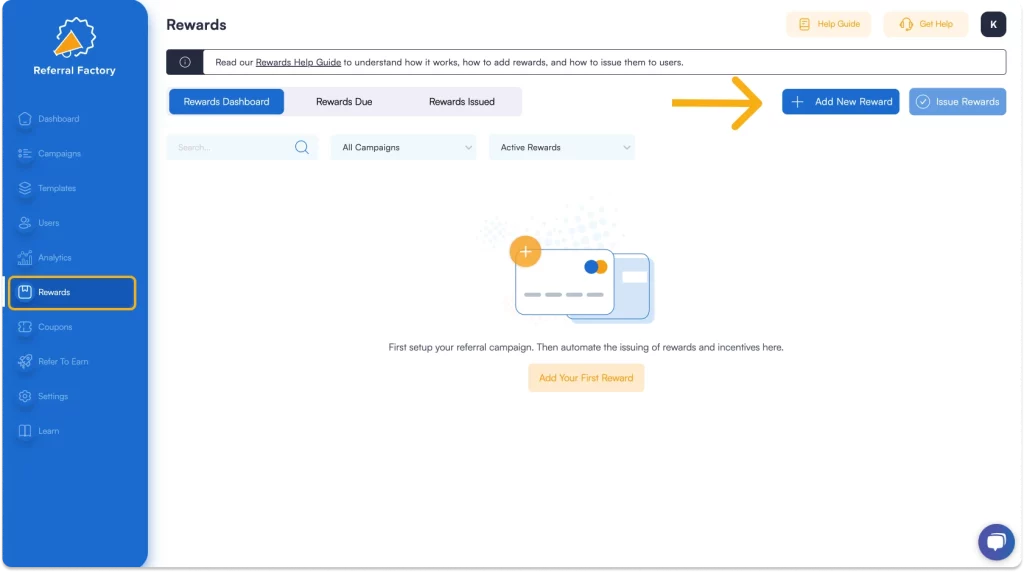
2️⃣ Create your reward by setting its name, choosing who to reward (person referring/person invited), and connecting a corresponding referral campaign. P.S.: You can incentivize both the person invited and the person referring simply by adding a reward for each!
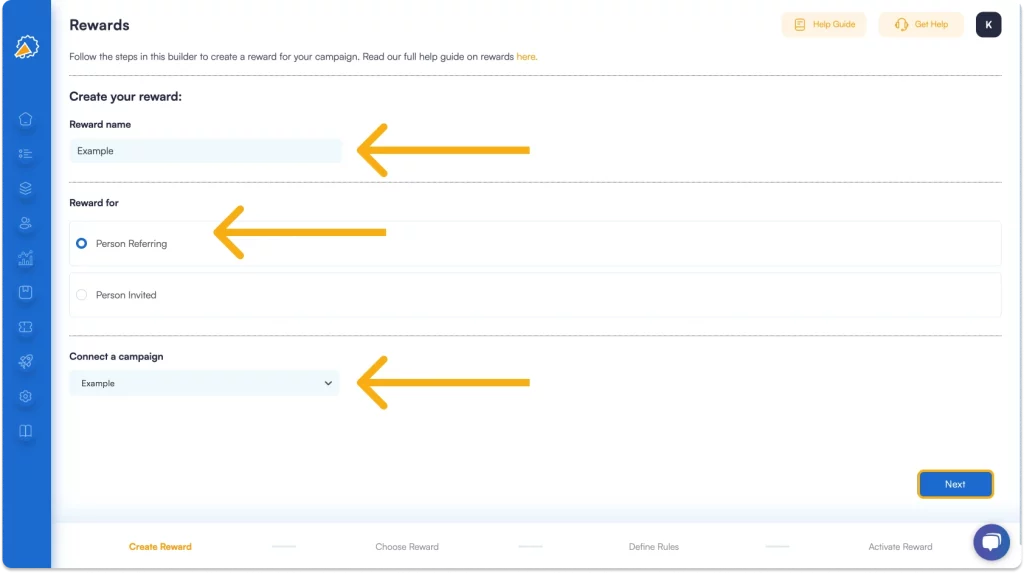
3️⃣ Choose the reward setup option. If you use one of our integrations (Tremendous, Webhooks, Zapier, and Stripe), choose and follow the instructions. Note: To continue with the setup, you need to have a corresponding account already. Alternatively, you can choose to issue your own reward, which will simply keep track of who needs a reward — you can then issue it yourself and mark it as complete on the system once you’re done.
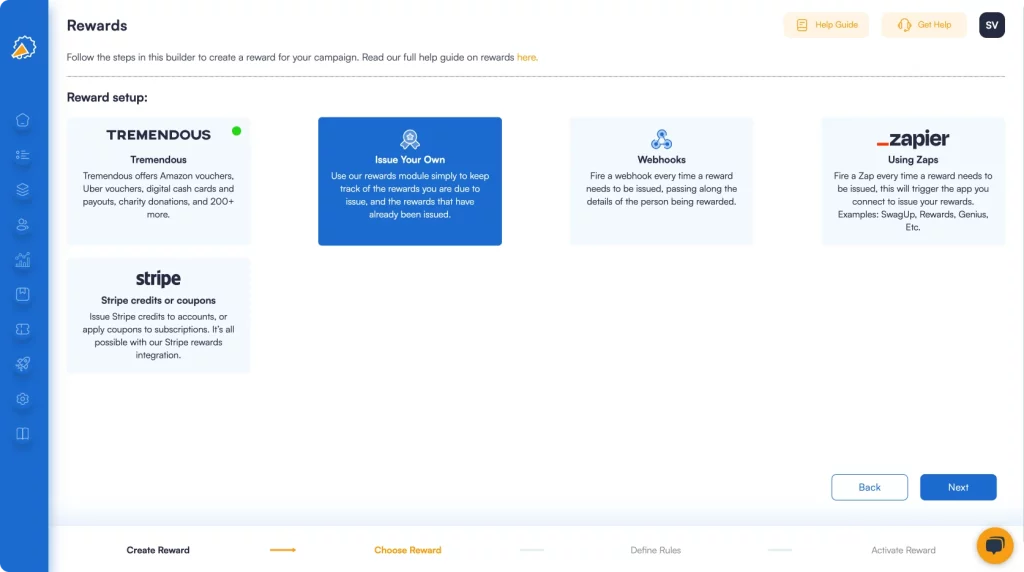
4️⃣ Next, define the rules for rewarding. With Referral Factory, you can issue fixed value, milestone, recurring or commission-based rewards. You can always check our help guide to learn more about adding and issuing rewards.
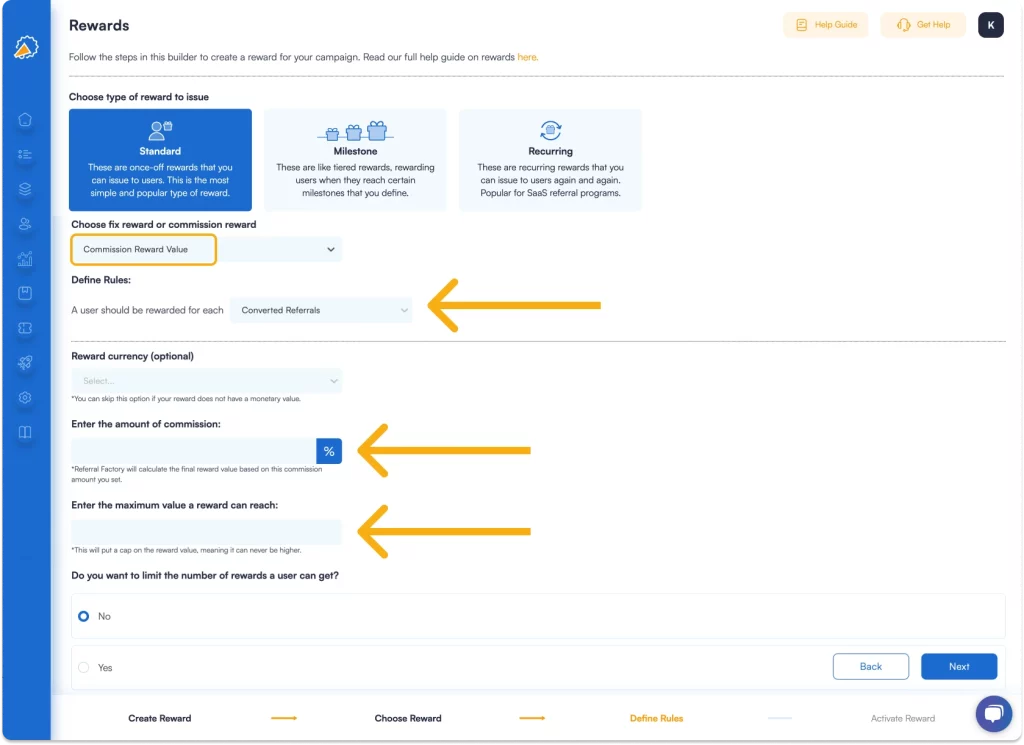
5️⃣ Now, the only thing left is to activate your reward by clicking the Activate button. If you wish to enable auto-issued rewards, you can enable the corresponding toggle. However, we DO NOT recommend this option, especially if you’re giving out monetary rewards.
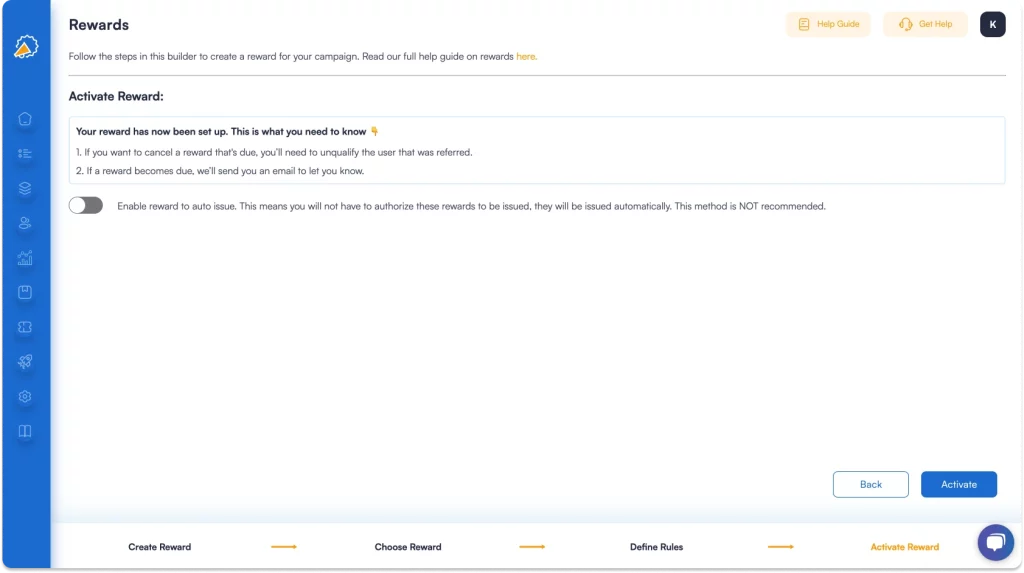
6️⃣ And there you go – your reward has been added and activated!
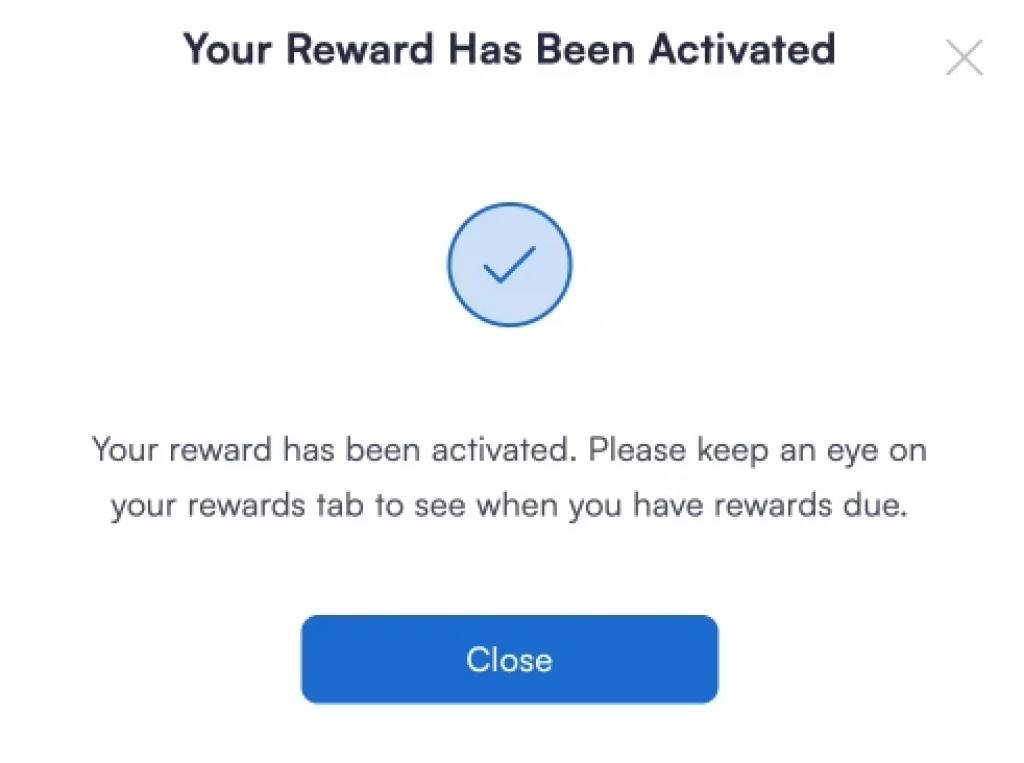
How to Issue a Reward in Referral Factory
Issuing rewards is even faster. You only need to follow these steps:
1️⃣ Go to Rewards > Rewards Due. Then, select all the rewards you want to issue by ticking the box and clicking the Issue Rewards button.
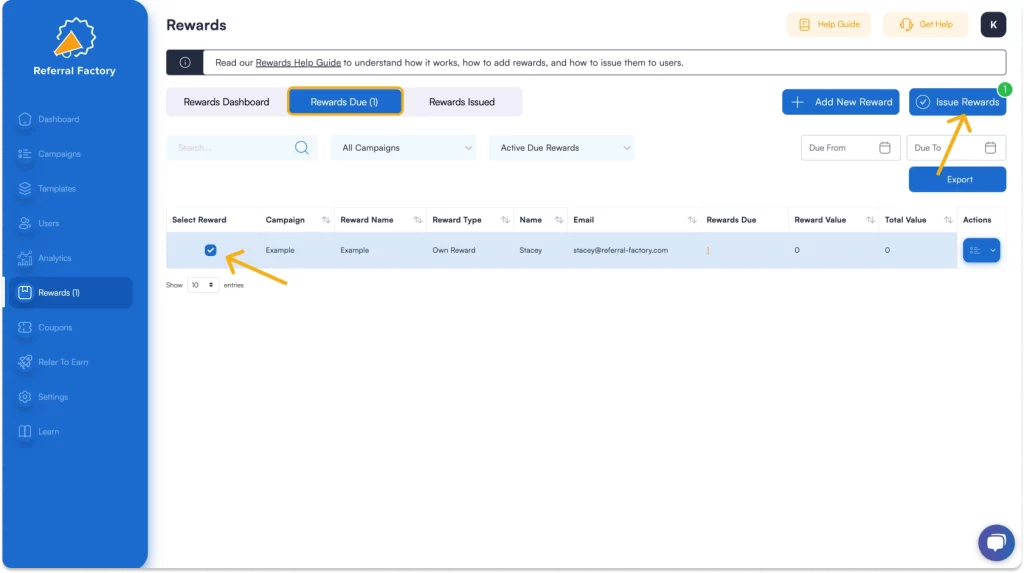
2️⃣ Confirm whether you want to issue the reward by clicking the Issue button.
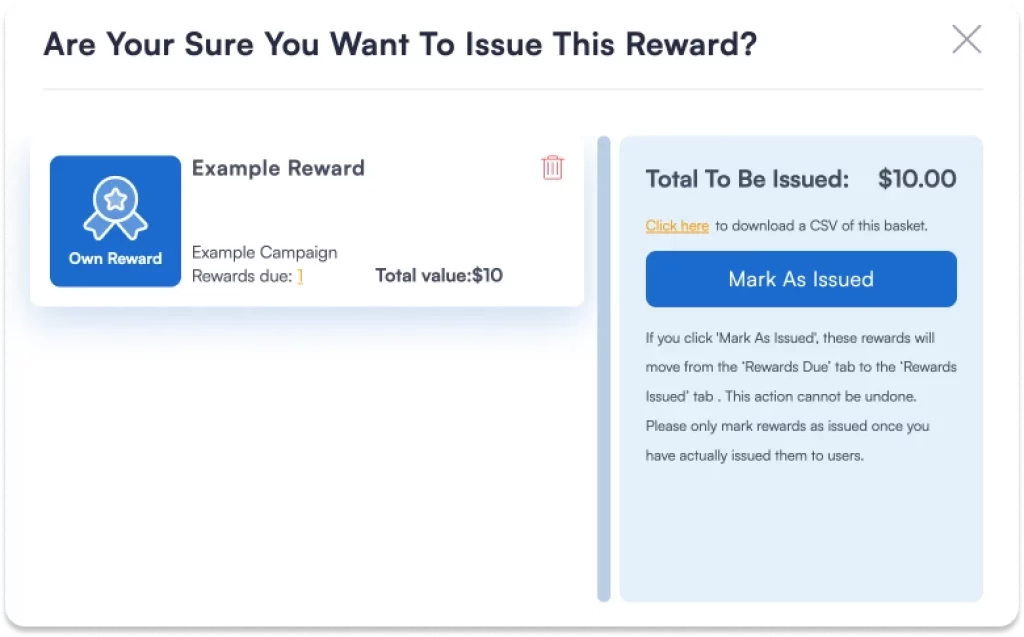
3️⃣ And voilà – you are fantastic!
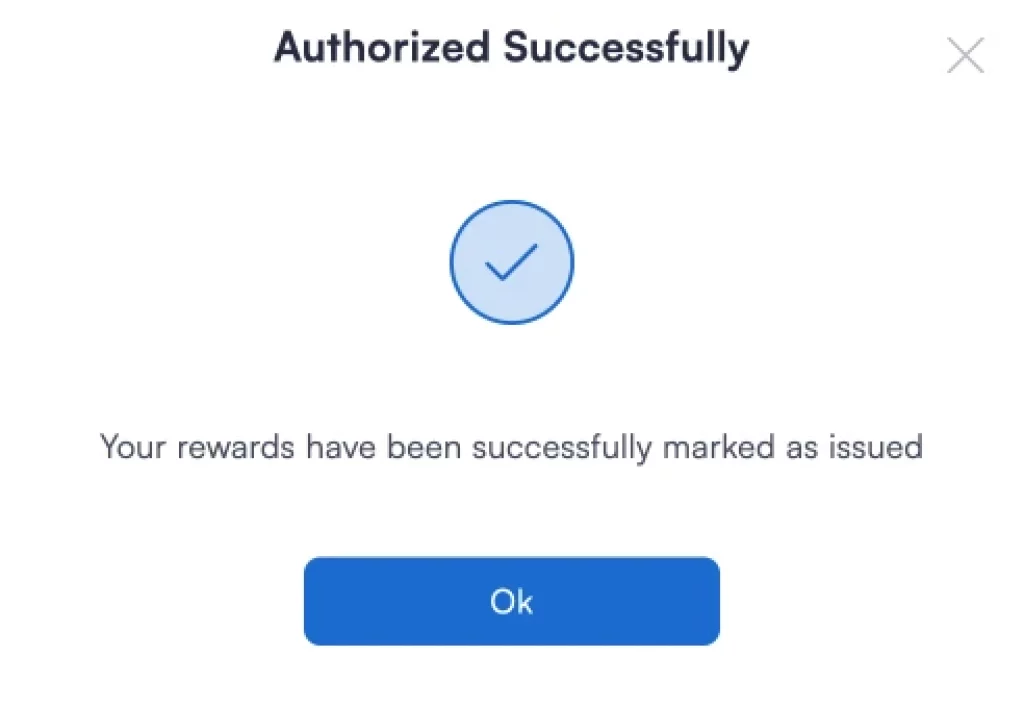
Conclusion
The best thing about a referral program can be packed into just two words: it works. And, with the right incentives, it works flawlessly. Make sure you’ve researched what motivates your audience the most. Also, don’t forget to keep it simple: no one will read lots of text, especially if it is unclear and complex. Moreover, complicated rules decrease the chances of getting more participants.
The key to a successful referral campaign lies in customization to your business goals and your customer preferences. The better you do this part, the better your results will be.
Good luck!




